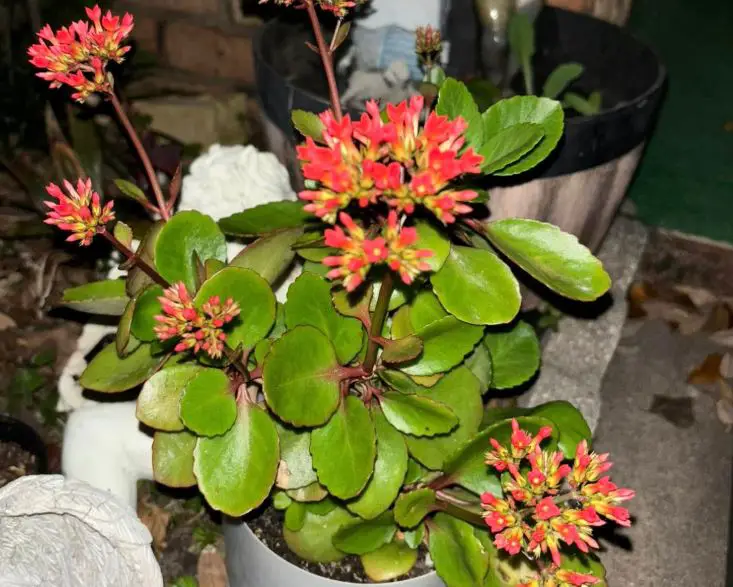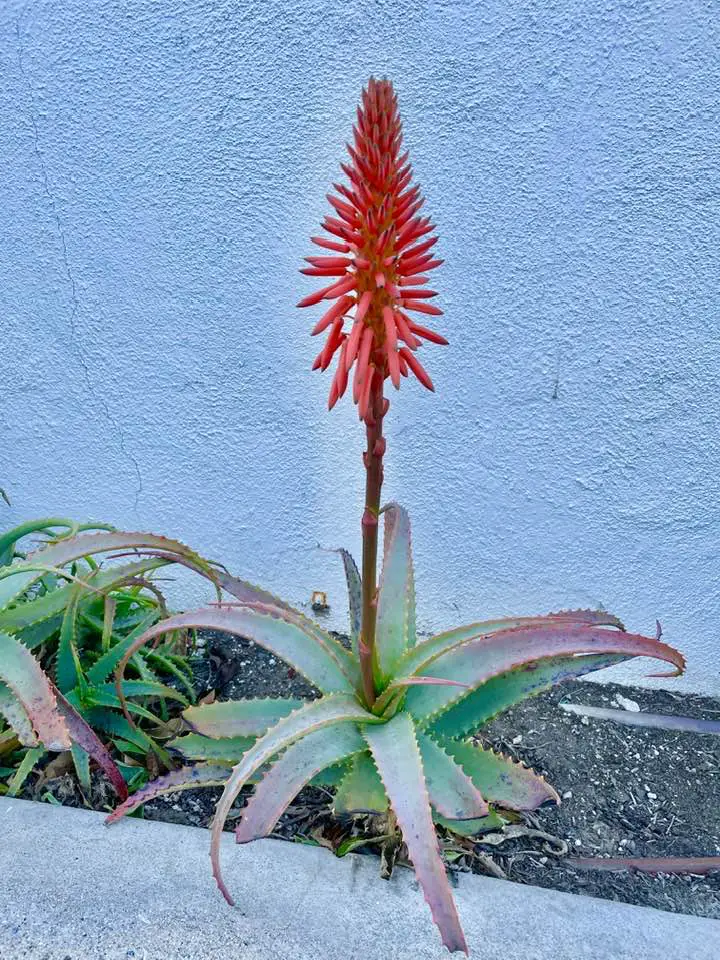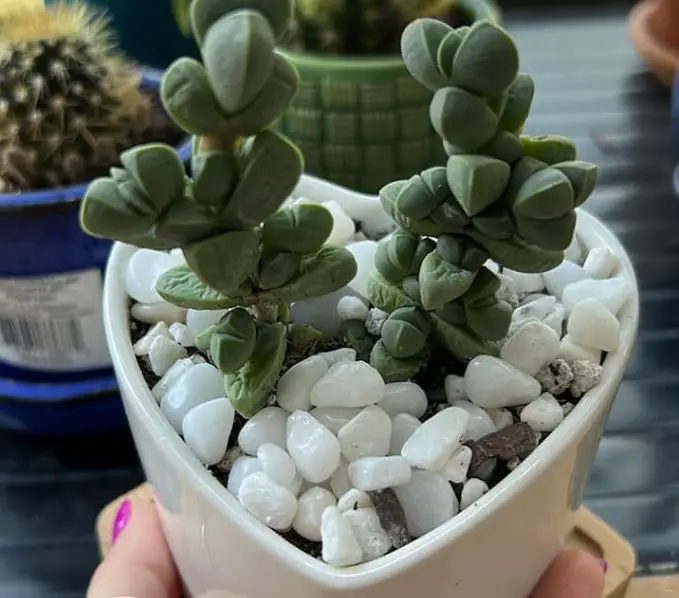Beginners Guide: How to Care for Echeveria Lipstick in Your Home
Echeveria agavoides ‘Lipstick’ is my absolute favorite succulent. Its vibrant lime-green leaves, kissed with fiery red edges, look like they’ve been dipped in a bold shade of lipstick—hence the name!
Native to the rocky, arid regions of Mexico, this stunning plant is perfect for every home. It’s low-maintenance, pet-safe, and adaptable to various climates, from the sunny Southwest to cooler northern regions.
Whether you’re a seasoned plant parent or a beginner looking to add some low-maintenance greenery to your space, I’ll walk you through everything you need to know to keep your Lipstick Echeveria thriving, from lighting to watering, soil, and even propagation.
I first fell in love with the Lipstick Echeveria when I saw its rosette shape and bold colors at a local nursery. Its thick, triangular leaves resemble an agave, earning it the name “agavoides” (meaning “resembling an agave”).
The red edges intensify under sunlight, giving it a dramatic flair that’s perfect for adding a pop of color to your home. Whether you place it on a sunny windowsill, a patio, or a rock garden, this succulent is a showstopper.
Echeveria Lipstick care requirements
To keep your succulent thriving, here are important things to know:
Optimal lighting for Lipstick Echeveria
Let it soak up the sun (but not too much). If there’s one thing I’ve learned about my Lipstick Echeveria, it’s that it loves light. This succulent needs at least six hours of bright, indirect sunlight daily to maintain its vibrant red edges.
In my home, I place mine near a south-facing window, where it gets plenty of light without being scorched. If you live in a region with intense sun, like Arizona or Texas, be cautious of direct afternoon rays, which can burn the leaves.
- Indoor Tip: If your home lacks natural light, especially in winter, invest in a grow light. I use a full-spectrum LED grow light for about 12 hours a day during the darker months, and my Echeveria stays happy.
- Outdoor Tip: In USDA Hardiness Zones 9a-11b, you can grow Lipstick Echeveria outdoors year-round. If you’re in a colder area, like New York or Chicago, bring it indoors before temperatures drop below 20°F (-6.7°C) to avoid frost damage.
If your plant starts to stretch or “etiolate” (grow tall and leggy), it’s reaching for more light. I made this mistake early on, and my Echeveria looked like it was doing yoga! Move it to a brighter spot, and rotate the pot occasionally to ensure even growth.
Watering – Less is more
Watering succulents can be tricky, but I’ve found the “soak and dry” method works wonders for my Lipstick Echeveria. Water thoroughly until it drains out of the pot’s holes, then wait until the soil is completely dry before watering again.
In my experience, this is about every 10-14 days indoors, depending on the season and humidity.
- Summer: During the growing season (spring and summer), I water mine every 7-10 days if it’s hot and dry.
- Winter: In cooler months, I cut back to once every 2-3 weeks since the plant goes semi-dormant.
Overwatering is the number one killer of succulents. I learned this the hard way when I left water sitting in the saucer, and my plant’s roots started to rot. If the leaves look translucent or mushy, you’re overwatering. Conversely, wrinkled leaves mean it’s thirsty.
The right soil and pot
Drainage is everything. Lipstick Echeveria thrives in well-draining soil. I use a mix of cactus potting soil with perlite or coarse sand at a 2:1 ratio. You can find pre-mixed cactus soil at most garden centers or online stores. Avoid rich, moisture-retaining soils, as they can lead to root rot.
Choose a pot with drainage holes—trust me, this is non-negotiable. I love terracotta or ceramic pots because they’re porous and help excess moisture evaporate. My Echeveria is in a 5-inch terracotta pot, and it’s been thriving for years.
- Repotting: Since Lipstick Echeveria is a slow grower, repot every 2-3 years in spring or summer. I water mine a couple of days before repotting to make the roots more pliable and check for any signs of rot. Choose a pot just one size larger to prevent excess soil from holding water.
Temperature and humidity
Keep it warm and dry. Echeveria Agavoides prefers temperatures between 60-75°F (15-24°C) and low to medium humidity (30-40%). High humidity, like in bathrooms or kitchens, can encourage mold and pests. I live in a humid area, so I keep a small fan near my succulents to improve air circulation.
In colder climates, protect your plant from frost. I bring mine indoors during winter, placing it away from drafty windows or vents. If you’re in a warm region like Southern California, you can keep it outdoors year-round, as long as it’s shielded from heavy rain.
Fertilizing – A light touch
Feed sparingly. Lipstick Echeveria isn’t a heavy feeder. I fertilize mine once in early spring with a diluted, balanced fertilizer (like 10-10-10) to give it a growth boost. Follow the manufacturer’s instructions and dilute it to half strength to avoid burning the roots.
Over-fertilizing can cause leggy growth, so less is more. If you’re unsure, skip fertilizing altogether—sunlight provides most of the plant’s energy.
Propagation – Grow Your Own Echeveria Babies
This succulent can be propagated from leaves, cuttings, or fffsets. One of the joys of owning a Lipstick Echeveria is propagating it to create new plants. I’ve tried all three methods and here’s what works best:
Leaf propagation
- Gently twist a healthy, plump leaf from the stem, ensuring no part remains on the plant.
- Let it callous over for 2-3 days in a dry, shaded spot.
- Place the leaf on well-draining soil and mist lightly every few days until roots and a new rosette form. This can take a few weeks, so be patient! I had a 50% success rate with this method, as some leaves rot or fail to root.
Stem Cuttings
- Use a sterile knife to cut a healthy stem, let it callous for a few days, then plant it in well-draining soil.
- Water sparingly until roots develop. I found this method faster than leaf propagation.
Offsets
Lipstick Echeveria occasionally produces “pups” or offsets at its base. I gently pull these off, let them dry for 1-2 days, and plant them in their own pots. This is the easiest method, though my plant doesn’t produce offsets often.
Propagation is like a science experiment—it’s so rewarding when you see tiny new plants forming!
Pruning and maintenance
Lipstick Echeveria doesn’t need much pruning, but I remove dead or dried lower leaves to prevent pests and encourage new growth. Use your fingers to gently pull them away, or snip with clean scissors.
If your plant gets leggy from insufficient light, you can trim the stem and propagate the top to start fresh. I did this once, and my new plant looked even better than the original
Common pests and problems
Stay vigilant. My Lipstick Echeveria has been mostly pest-free, but mealybugs can be an issue. These tiny white bugs love to hide in the rosette. If I spot them, I dab them with a cotton swab dipped in rubbing alcohol. For more severe infestations, I use neem oil diluted with water.
Other issues to watch for:
- Mushy or translucent leaves indicate root rot. Cut back on watering and check the roots.
- Wrinkled leaves mean it needs a drink.
- Leggy growth or pale leaves suggest it needs more sun.
Styling Lipstick Echeveria in Your Home
I love how versatile Lipstick Echeveria is for home decor. Its compact size (up to 12 inches wide and 6 inches tall) makes it perfect for small spaces. Here are some ideas:
- Windowsills: Place it in a colorful ceramic pot for a pop of color.
- Terrariums: Pair it with other succulents in a glass terrarium for a mini desert vibe.
- Rock gardens: If you’re in a warm climate, plant it in a sunny rock garden with cacti and gravel.
- Patio displays: Group it with other Echeverias for a stunning outdoor arrangement.
I have mine on my kitchen counter in a terracotta pot, and it’s a conversation starter whenever guests visit. Its vibrant colors complement any decor style, from modern to bohemian.
Seasonal Care Tips for the U.S.A. Climates
When I first brought my Lipstick Echeveria home, I was nervous about keeping it alive. I’m not a natural green thumb, but this plant has been so forgiving. I’ve made mistakes—like overwatering or forgetting to move it to a brighter spot—but it bounced back every time.
Watching its red edges deepen under sunlight feels like a little victory, and propagating my first offset was so exciting! This succulent has taught me patience and the joy of nurturing something beautiful. Here are my go-to season care tips for American enthusiasts.
Spring and Summer
This is the growing season for Lipstick Echeveria. I increase watering slightly and fertilize once in early spring. If you’re in a warm region like Florida or California, move it outdoors for extra sunlight, but provide shade during intense afternoon heat.
Fall and Winter
In colder areas like the Midwest or Northeast, bring your Echeveria indoors before the first frost. I reduce watering to once every 2-3 weeks and keep it near a sunny window. If you’re in a mild climate, like coastal California, it can stay outside with minimal protection.
Where to Buy Lipstick Echeveria
You can find Lipstick Echeveria at local nurseries, garden centers, or online retailers. Here are some trusted sources:
- Succulents Box for a wide variety of Echeverias.
- Plant Addicts for healthy, shipped-to-your-door plants.
- Monrovia for nursery-quality succulents.
I bought mine from a local nursery, but online options are great if you don’t have access to a garden center.
FAQs
Here are quick answers to the frequently asked questions about Echeveria Agavoides ‘Lipstick’
Q: How often should I water my Lipstick Echeveria?
A: Water every 10-14 days indoors, allowing the soil to dry out completely between waterings. Adjust based on your climate and season.
Q: Can I grow Lipstick Echeveria indoors year-round?
A: Yes, as long as it gets 6+ hours of bright, indirect light. Use a grow light in low-light conditions.
Q: Why are the red edges fading?
A: Fading red edges usually mean insufficient sunlight. Move your plant to a brighter spot to enhance its color.
Q: Is Lipstick Echeveria pet-safe?
A: Yes, it’s non-toxic to cats and dogs, making it a great choice for pet owners.
Q: How do I propagate my Lipstick Echeveria?
A: Use leaf propagation, stem cuttings, or offsets. Leaf propagation is the most common but requires patience. See the propagation section above for details.
Final Thoughts
Caring for Echeveria agavoides ‘Lipstick’ is a rewarding experience for any plant lover. Its striking appearance, low-maintenance needs, and adaptability make it a perfect addition to homes across the country.
By providing bright light, well-draining soil, minimal water, and occasional TLC, you’ll have a thriving succulent that adds beauty to your space. Whether you’re in a sunny desert or a chilly northern city, this plant can flourish with the right care.
Share your experiences or questions in the comments below—I’d love to hear how your Echeveria journey goes!
Tim M Dave is a gardening expert with a passion for houseplants, particularly cacti and succulents. With a degree in plant biology from the University of California, Berkeley, he has vast experience in gardening. Over the years, he has cultivated a vast collection of desert plants and learned a great deal about how to grow and care for these unique companions.






